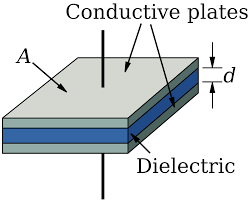Parallel Plate Capacitance Calculator is a tool to calculate the Capacitance of a parrel plate capacitor. A parallel plate capacitor is a simple type of capacitor that consists of two parallel conducting plates separated by a dielectric material. The conducting plates are typically made of metal and have a large surface area. The dielectric material is an insulator that can store electrical energy.
Parallel Plate Capacitance Calculator
When a voltage is applied across the parallel plate capacitor, a potential difference is established between the plates. The positive charges accumulate on one plate, while an equal amount of negative charges accumulates on the other plate. This creates an electric field between the plates, with electric field lines running perpendicular to the plates.

The capacitance of a parallel plate capacitor is determined by several factors, including the area of the plates, the distance between them (also known as the plate separation or gap), and the permittivity of the dielectric material. The capacitance (C) of a parallel plate capacitor can be calculated using the formula:
C = (ε₀ * εᵣ * A) / d
where ε₀ is the permittivity of free space (approximately 8.854 × 10⁻¹² F/m), εᵣ is the relative permittivity (dielectric constant) of the material between the plates, A is the area of each plate, and d is the distance between the plates.
The parallel plate capacitor is commonly used in various electronic circuits and systems to store and release electrical energy. It is often found in applications such as power supplies, filters, and energy storage devices, and as a component in timing circuits or signal coupling.
Calculations Involved
To calculate the capacitance of a parallel plate capacitor, you can use the formula:
C = (ε₀ * εᵣ * A) / d
where:
- C is the capacitance in Farads (F)
- ε₀ is the permittivity of free space, approximately 8.854 × 10⁻¹² F/m
- εᵣ is the relative permittivity (dielectric constant) of the material between the plates
- A is the area of each plate in square meters (m²)
- d is the distance between the plates in meters (m)
Here’s a step-by-step guide on how to perform the calculations:
- Determine the values of εᵣ, A, and d for your parallel plate capacitor. εᵣ can usually be found in the specifications or datasheet of the dielectric material you are using. A and d can be measured or known from the design of your capacitor.
- Plug the values into the formula: C = (8.854 × 10⁻¹² * εᵣ * A) / d
- Multiply ε₀ (8.854 × 10⁻¹²) by εᵣ, then multiply the result by A.
- Divide the previous result by d to obtain the capacitance C.
- The resulting value will be the capacitance of your parallel plate capacitor, expressed in Farads (F).
It’s important to note that the units used for the calculations must be consistent. For example, if the area is given in square centimeters (cm²), it should be converted to square meters (m²) before performing the calculation.
Additionally, keep in mind that the dielectric constant may vary depending on the material used. It is crucial to use the appropriate dielectric constant value for accurate calculations. Consult the specifications or literature for the specific dielectric material you are using.
Important Links